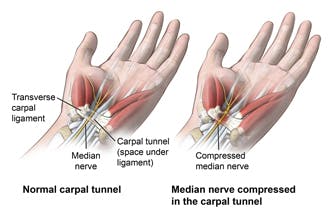Carpal tunnel syndrome is the most common nerve injury affecting adults. More than 3 million Americans are diagnosed each year. It is more common in women. Common conditions linked to carpal tunnel syndrome include neck pain, diabetes, and pregnancy. Workplace factors also contribute. Performing repetitive wrist and finger movements like typing, nursing, and cleaning increases pressure and stress within the carpal tunnel. Surgery is a very effective treatment choice. However, many do not realize exercise also helps people with mild to moderate carpal tunnel syndrome.
What is Carpal Tunnel Syndrome?

Carpal tunnel syndrome results from irritation or compression of the median nerve as it passes through the carpal tunnel in your wrist. The tendons that bend your fingers also pass through this tunnel. Repetitive wrist and hand movements increase swelling and pressure within the tunnel.
As your tendons swell and thicken they restrict blood flow to your nerve. Nerves require blood and movement or they will start to act funny. When your median nerve acts up, you experience pain or numbness and tingling in your thumb, index, middle, and ring fingers. Symptoms are likely worse at night or when you do repetitive movements. Both these situations increase pressure within your carpal tunnel.
A Proven Approach to Manage Carpal Tunnel Syndrome
Thankfully, multiple research studies have proved exercise reduces symptoms of carpal tunnel syndrome. These exercises gently move the tendons and nerves within the tunnel. Movement reduces swelling within the tunnel and restores blood flow to your irritated nerve.
When performed regularly for several weeks symptoms will begin to diminish. Also, combining exercise with night splints enhances results in many people. The exercises are easy to perform and do not require much time. The following 3 videos show some of the more common exercises physical therapists prescribe.
Tendon Gliding Exercises
The gentle movement of the tendons within your carpal tunnel improves blood flow to irritated tendons and nerves. To perform tendon gliding exercises, sit upright in a chair with your elbow bent and on a pillow. Position your hand in front of your face. Begin with your fingers in a straight position. Then sequentially move through a hook, fist, table top, and straight fist position. Hold each position for 2 to 3 seconds. Perform at least 10 repetitions in each position 2 to 3 times each day.
Nerve Gliding Exercises
Nerve gliding exercises slide the median nerve back and forth within the carpal tunnel. This improves mobility and blood flow to your irritated nerves. These exercises should be performed gently with minimal to no pain or tingling.
The first exercise involves movement of your wrist and fingers. Sit upright in a chair with your elbow bent resting on a pillow. Position your hand in front of your face. Begin with your fingers in a closed-fist position. Then sequentially move through 5 steps. First, straighten your fingers fully. Second, extend your wrist back. Third, separate your thumb from the other 4 fingers. Fourth, turn your forearm so your palm is facing you. Finally, apply gentle pressure with your other hand to stretch the thumb back. Hold each position for 2 to 3 seconds. Perform at least 10 repetitions in each position 2 to 3 times per day.
The second exercise involves movement of your elbow and wrist. This exercise results in the greatest amount of movement of the nerve within your carpal tunnel. Stand with your arm stretched out to your side. The elbow is straight, palm up, and fingers straight. Imagine you are holding a plate of food in your hand. Next, simultaneously bend your elbow and extend your wrist. Continue imagining you are holding a plate in your hand as you move back and forth. Perform at least 10 repetitions 2 to 3 times per day.
Begin These Carpal Tunnel Exercises Today
Carpal tunnel syndrome symptoms can range from an annoyance to debilitating pain. In many people, it severely disturbs sleep and the ability to carry out routine daily activities. Regular exercise can alleviate much of the distress.
In order to achieve the best results, exercises should be performed multiple times each day. Infrequent or random exercise will do little good. Give these 3 exercises a shot for at least 6 weeks and see how you do.
If you want more help give us a call. Our physical therapists can help you find the right exercises and supplement these with massage and other manual therapy treatments. You don’t have to keep suffering and you have options other than surgery.

